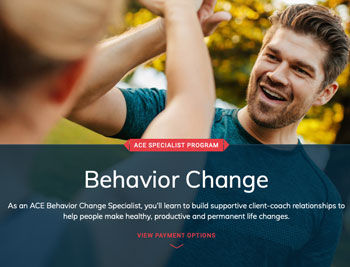

Does this sound familiar?
Your client wants to run their first 5K later this month, but they continually come up with reasons for why they didn’t follow the training schedule the two of you set up months ago. Consequently, they’re still in the “walking” phase of the training program and nowhere near ready to run it.
Another client wants to add more fruits and vegetables to their diet, but instead opts for chips and dip every day for their afternoon snack. Potato chips, they claim, count as a vegetable—and even more so if they use a “garden vegetable” dip.
As a health and exercise professional, it can be tempting to conclude that these clients are being resistant and simply aren’t ready—or willing—to change. However, there may be an underlying issue brewing beneath the surface: cognitive dissonance.
What Is Cognitive Dissonance?
“Cognitive dissonance, in its most simple terms, is our desire for our beliefs to be aligned with our actions,” explains Melissa Orshan Spann, PhD, CEDS-S, chief clinical officer at Monte Nido and Affiliates in Miami, Fla. “Subsequently, the feelings that arise when that congruence is not present is the cognitive dissonance.”
Cognitive dissonance, says Orshan Spann, can present itself in many ways. “For example, this can be seen in someone who values a healthy lifestyle, but engages in unhealthy behaviors, such as smoking or excessive alcohol intake. Another example would be someone who values exercise, but might take it to the extreme, which will negatively impact their body in the process.”
“Especially in the health and fitness field, cognitive dissonance is a common occurrence,” argues Eliza Kingsford, MA, LPC, licensed psychotherapist, behavior change specialist and author of Brain-Powered Weight Loss. “Cognitive dissonance occurs when there is a situation involving conflicting attitudes, beliefs or behaviors. This produces feelings of mental discomfort, leading to trying to change one of the attitudes, beliefs or behaviors in an effort to reduce the discomfort and restore balance.”
As an example, Kingsford describes someone who wants to get healthier, but doesn’t want to get moving. “Cognitive dissonance comes up a lot when someone cognitively wants something that is in direct opposition to their daily actions—like someone who wants to buy a house but spends their savings on shopping instead.”
Ultimately, adds Patti Ashley, PhD, LPC, psychotherapist, speaker and author of Shame-Informed Therapy: Treatment Strategies for Overcoming Core Shame and Reconstructing the Authentic Self, cognitive dissonance can cause shame. “Cognitive dissonance occurs when the logical part of the brain gets hijacked by old unconscious, nonverbal beliefs or sensations of not being good enough. Brain researchers have now identified this as neurobiological shame.”
Ashely continues: “When a client is triggered by something that activates a shame response, false stories take over, such as, ‘I’m not enough,’ ‘I’m a failure,’ ‘What is wrong with me?’ ‘I’ll never get it right’ and so on. [These stories] start to run the show. The prefrontal cortex goes offline and the amygdala, a primitive part of the brain, goes into overdrive. This can create a type of cognitive dissonance where the client is unable to access higher levels of thinking. Shame takes control of the wheel, so to speak.”
Kingsford concurs. “Even though someone may have a cognitive desire—to lose weight, for example—they often hold beliefs or old identities that will keep them from acting on that desire—like ‘Losing weight is hard and I always fail, so why bother trying?’ This is where the cognitive dissonance is felt most strongly. There is a tug of war between what someone wants and old beliefs or patterns that are deeply ingrained in the [primitive], reptilian part of the brain.”
Kingsford describes this reptilian brain as the part of the brain that doesn’t care about what you want. Its job is simply to keep you safe and alive. “It only cares about homeostasis,” she says. “This means that whenever you try and change something—like starting a new workout routine—this part of the brain will fight to resist change, because it interprets any change as dangerous. Even if you really do want to change, your reptilian brain will resist, creating cognitive dissonance and emotional discomfort.”
With this mind, as health and exercise professionals, we need to be careful about making assumptions about our clients’ seeming lack of motivation. “Don’t make assumptions about someone’s desires,” warns Kingsford. “Many trainers [and coaches] mistake dissonance for laziness or lack of priorities. The brain is incredibly powerful, and it largely controls our actions and behaviors.”
Clients are not being dishonest about what they want, Kingsford continues. “They do feel like they have a desire to change. However, this desire to change comes from the newest part of the brain responsible for thinking. What is holding them back from acting on these desires comes from a different part of the brain altogether—this reptilian brain. Assuming your client is lazy or unmotivated just makes the dissonance worse.”
Orshan-Spann explains that experiencing this chasm between what someone believes and what they do can keep them stuck in their own mind. “Cognitive dissonance presents differently in everybody. For some, it might be a little voice in their heads and for others it might present as powerful feelings of anxiety. Overall, the experiences of distress that occur when our beliefs do not match our actions can lead someone to be stuck in perpetual patterns of inaction.”
I Think My Client May Be Experiencing Cognitive Dissonance. Now What?
As a health and exercise professional, encouraging your clients to identify their values is essential to helping them move from “stuck” mode to “growth” mode. “One of the keys in working with clients experiencing cognitive dissonance,” advises Orshan-Spann, “is to increase self-awareness around values, beliefs and behaviors when identifying someone’s core values. From there, coaches could work with clients to see how those values, beliefs and actions are impacting the decisions the client is making. The overall goal is to understand where the dissonance is coming from, while actively deciding to do something different.”
“Awareness is an incredibly powerful first step when dealing with cognitive dissonance and overcoming obstacles,” agrees Kingsford. “Being able to gently point out that there is a block or a barrier between what your client says they want and how they behave is a good first step.”
She suggests highlighting the dissonance, as this will allow you to work with it. For example, if a client’s goal is to get stronger, she says you could say something like, “You have said your biggest goal with me is to create new muscle, but what your actions tell me is that something is holding you back. Tell me a little bit more about what is making this so difficult for you.”
Ashley believes empathy is the antidote to shame caused by cognitive dissonance. “Pay attention to your client’s body language,” she suggests. “Sometimes the client may appear less engaged, extra shy or even agitated. These can be clues to cognitive dissonance.”
Ashley goes on to say that when experiencing cognitive dissonance, we tend to take shallow breaths, which makes it harder to access the frontal lobe and make rational decisions. “Take some deep breaths yourself and model deep breathing for your client,” she recommends. “Keep in mind that mirror neurons in the frontal lobe are activated in another person’s mind when in deliberate interactions, so the other person may have a similar experience as you.” She cites yawning as an example; when someone yawns, you will also yawn.
This type of interaction can go even deeper. “Holding unconditional positive regard for the client in your mind can actually be felt by the client and help them regulate and be more present,” continues Ashley. “And whatever you can do to connect the dots for the client to make them more aware of the false story helps you understand and talk to them about it.”
Ashley cautions to be careful about the timing so as to not incite shame. “Making the connections in your mind is a good first start, and reflecting back insights that the client may share is also helpful. We all feel better when we know we are being heard.”
“Our brains and bodies have one job,” explains Kingsford, “[and that’s] to keep us safe and alive. In some ways, the brain is quite primitive. It will encourage you to do things, even if they aren’t good for you, because doing those things has kept you alive up to this point. The brain interprets those actions as the best things for you to do to stay alive. In this way, we need to better understand how people work, and work with the brain instead of fighting against it, often creating more dissonance.”
And be patient, adds Ashley. “Studies have shown that it takes a long time to change these old unconscious stories, so be patient with both yourself and your client. Pay attention to your own responses, so that you can stay strong and present for clients, always meeting them with empathy and positive regard.”
Expand Your Knowledge

ACE Health Coach Certification
The ACE Health Coach Certification is the only health coach certification accredited by the National Commission for Certifying Agencies (NCCA), considered the gold standard in health and fitness. Rooted in behavior-change science and the principles of lifestyle medicine, the study and training program addresses all the core competencies of health coaching within a single learning experience. You will learn practical and effective strategies that can be implemented to facilitate lifestyle change and positively impact health and well-being.

Behavior Change Specialist
The ACE Behavior Change Specialist Program teaches you the key tools to promoting behavior change and creating a foundation for a healthy lifestyle. Learn how to help clients of all backgrounds recognize counterproductive behaviors and coach them to discover new methods to move more, eat better and make healthier decisions for themselves and their families. You’ll gain crucial communication skills to foster effective client-coach relationships and learn cognitive behavioral coaching to help your clients reach their potential.

Overcoming the “I Hate Change” Mentality
This video training covers how to turn negative attitudes into a source of motivation by asking the right questions at the right time. This course explores how you can make attainable goals that align with your values and become more confident in your journey through behavior change. And, it will empower you to help your clients navigate through their own “stinking thinking.” Learn to develop and solidify relationships based on trust and empathy so that clients will keep coming back and referring friends and loved ones.





 by
by 





